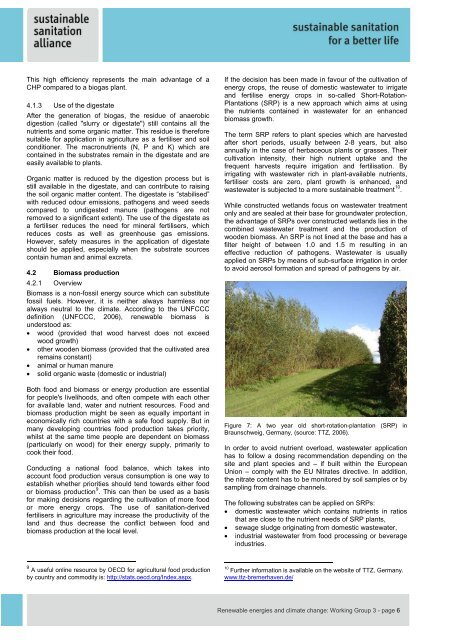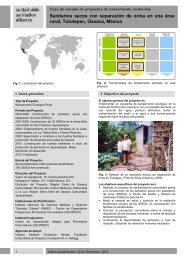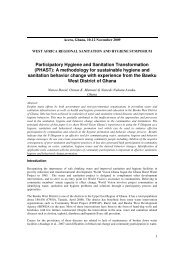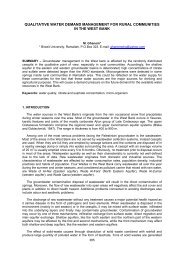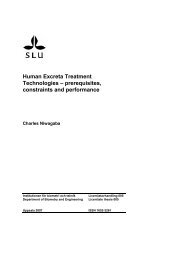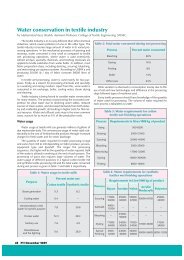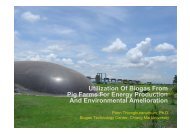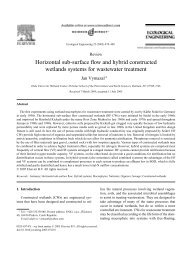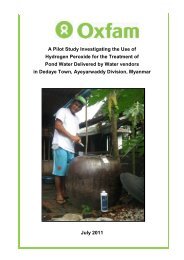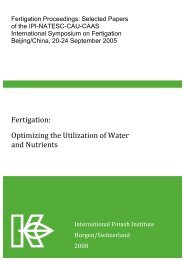Compilation of 13 factsheets on key sustainable sanitation ... - SSWM
Compilation of 13 factsheets on key sustainable sanitation ... - SSWM
Compilation of 13 factsheets on key sustainable sanitation ... - SSWM
Create successful ePaper yourself
Turn your PDF publications into a flip-book with our unique Google optimized e-Paper software.
This high efficiency represents the main advantage <str<strong>on</strong>g>of</str<strong>on</strong>g> a<br />
CHP compared to a biogas plant.<br />
4.1.3 Use <str<strong>on</strong>g>of</str<strong>on</strong>g> the digestate<br />
After the generati<strong>on</strong> <str<strong>on</strong>g>of</str<strong>on</strong>g> biogas, the residue <str<strong>on</strong>g>of</str<strong>on</strong>g> anaerobic<br />
digesti<strong>on</strong> (called "slurry or digestate") still c<strong>on</strong>tains all the<br />
nutrients and some organic matter. This residue is therefore<br />
suitable for applicati<strong>on</strong> in agriculture as a fertiliser and soil<br />
c<strong>on</strong>diti<strong>on</strong>er. The macr<strong>on</strong>utrients (N, P and K) which are<br />
c<strong>on</strong>tained in the substrates remain in the digestate and are<br />
easily available to plants.<br />
Organic matter is reduced by the digesti<strong>on</strong> process but is<br />
still available in the digestate, and can c<strong>on</strong>tribute to raising<br />
the soil organic matter c<strong>on</strong>tent. The digestate is “stabilised”<br />
with reduced odour emissi<strong>on</strong>s, pathogens and weed seeds<br />
compared to undigested manure (pathogens are not<br />
removed to a significant extent). The use <str<strong>on</strong>g>of</str<strong>on</strong>g> the digestate as<br />
a fertiliser reduces the need for mineral fertilisers, which<br />
reduces costs as well as greenhouse gas emissi<strong>on</strong>s.<br />
However, safety measures in the applicati<strong>on</strong> <str<strong>on</strong>g>of</str<strong>on</strong>g> digestate<br />
should be applied, especially when the substrate sources<br />
c<strong>on</strong>tain human and animal excreta.<br />
4.2 Biomass producti<strong>on</strong><br />
4.2.1 Overview<br />
Biomass is a n<strong>on</strong>-fossil energy source which can substitute<br />
fossil fuels. However, it is neither always harmless nor<br />
always neutral to the climate. According to the UNFCCC<br />
definiti<strong>on</strong> (UNFCCC, 2006), renewable biomass is<br />
understood as:<br />
• wood (provided that wood harvest does not exceed<br />
wood growth)<br />
• other wooden biomass (provided that the cultivated area<br />
remains c<strong>on</strong>stant)<br />
• animal or human manure<br />
• solid organic waste (domestic or industrial)<br />
Both food and biomass or energy producti<strong>on</strong> are essential<br />
for people's livelihoods, and <str<strong>on</strong>g>of</str<strong>on</strong>g>ten compete with each other<br />
for available land, water and nutrient resources. Food and<br />
biomass producti<strong>on</strong> might be seen as equally important in<br />
ec<strong>on</strong>omically rich countries with a safe food supply. But in<br />
many developing countries food producti<strong>on</strong> takes priority,<br />
whilst at the same time people are dependent <strong>on</strong> biomass<br />
(particularly <strong>on</strong> wood) for their energy supply, primarily to<br />
cook their food.<br />
C<strong>on</strong>ducting a nati<strong>on</strong>al food balance, which takes into<br />
account food producti<strong>on</strong> versus c<strong>on</strong>sumpti<strong>on</strong> is <strong>on</strong>e way to<br />
establish whether priorities should tend towards either food<br />
or biomass producti<strong>on</strong> 9<br />
. This can then be used as a basis<br />
for making decisi<strong>on</strong>s regarding the cultivati<strong>on</strong> <str<strong>on</strong>g>of</str<strong>on</strong>g> more food<br />
or more energy crops. The use <str<strong>on</strong>g>of</str<strong>on</strong>g> sanitati<strong>on</strong>-derived<br />
fertilisers in agriculture may increase the productivity <str<strong>on</strong>g>of</str<strong>on</strong>g> the<br />
land and thus decrease the c<strong>on</strong>flict between food and<br />
biomass producti<strong>on</strong> at the local level.<br />
9 A useful <strong>on</strong>line resource by OECD for agricultural food producti<strong>on</strong><br />
by country and commodity is: http://stats.oecd.org/Index.aspx.<br />
If the decisi<strong>on</strong> has been made in favour <str<strong>on</strong>g>of</str<strong>on</strong>g> the cultivati<strong>on</strong> <str<strong>on</strong>g>of</str<strong>on</strong>g><br />
energy crops, the reuse <str<strong>on</strong>g>of</str<strong>on</strong>g> domestic wastewater to irrigate<br />
and fertilise energy crops in so-called Short-Rotati<strong>on</strong>-<br />
Plantati<strong>on</strong>s (SRP) is a new approach which aims at using<br />
the nutrients c<strong>on</strong>tained in wastewater for an enhanced<br />
biomass growth.<br />
The term SRP refers to plant species which are harvested<br />
after short periods, usually between 2-8 years, but also<br />
annually in the case <str<strong>on</strong>g>of</str<strong>on</strong>g> herbaceous plants or grasses. Their<br />
cultivati<strong>on</strong> intensity, their high nutrient uptake and the<br />
frequent harvests require irrigati<strong>on</strong> and fertilisati<strong>on</strong>. By<br />
irrigating with wastewater rich in plant-available nutrients,<br />
fertiliser costs are zero, plant growth is enhanced, and<br />
wastewater is subjected to a more <strong>sustainable</strong> treatment 10<br />
.<br />
While c<strong>on</strong>structed wetlands focus <strong>on</strong> wastewater treatment<br />
<strong>on</strong>ly and are sealed at their base for groundwater protecti<strong>on</strong>,<br />
the advantage <str<strong>on</strong>g>of</str<strong>on</strong>g> SRPs over c<strong>on</strong>structed wetlands lies in the<br />
combined wastewater treatment and the producti<strong>on</strong> <str<strong>on</strong>g>of</str<strong>on</strong>g><br />
wooden biomass. An SRP is not lined at the base and has a<br />
filter height <str<strong>on</strong>g>of</str<strong>on</strong>g> between 1.0 and 1.5 m resulting in an<br />
effective reducti<strong>on</strong> <str<strong>on</strong>g>of</str<strong>on</strong>g> pathogens. Wastewater is usually<br />
applied <strong>on</strong> SRPs by means <str<strong>on</strong>g>of</str<strong>on</strong>g> sub-surface irrigati<strong>on</strong> in order<br />
to avoid aerosol formati<strong>on</strong> and spread <str<strong>on</strong>g>of</str<strong>on</strong>g> pathogens by air.<br />
Figure 7: A two year old short-rotati<strong>on</strong>-plantati<strong>on</strong> (SRP) in<br />
Braunschweig, Germany, (source: TTZ, 2006).<br />
In order to avoid nutrient overload, wastewater applicati<strong>on</strong><br />
has to follow a dosing recommendati<strong>on</strong> depending <strong>on</strong> the<br />
site and plant species and – if built within the European<br />
Uni<strong>on</strong> – comply with the EU Nitrates directive. In additi<strong>on</strong>,<br />
the nitrate c<strong>on</strong>tent has to be m<strong>on</strong>itored by soil samples or by<br />
sampling from drainage channels.<br />
The following substrates can be applied <strong>on</strong> SRPs:<br />
• domestic wastewater which c<strong>on</strong>tains nutrients in ratios<br />
that are close to the nutrient needs <str<strong>on</strong>g>of</str<strong>on</strong>g> SRP plants,<br />
• sewage sludge originating from domestic wastewater,<br />
• industrial wastewater from food processing or beverage<br />
industries.<br />
10<br />
Further informati<strong>on</strong> is available <strong>on</strong> the website <str<strong>on</strong>g>of</str<strong>on</strong>g> TTZ, Germany.<br />
www.ttz-bremerhaven.de/<br />
Renewable energies and climate change: Working Group 3 - page 6


